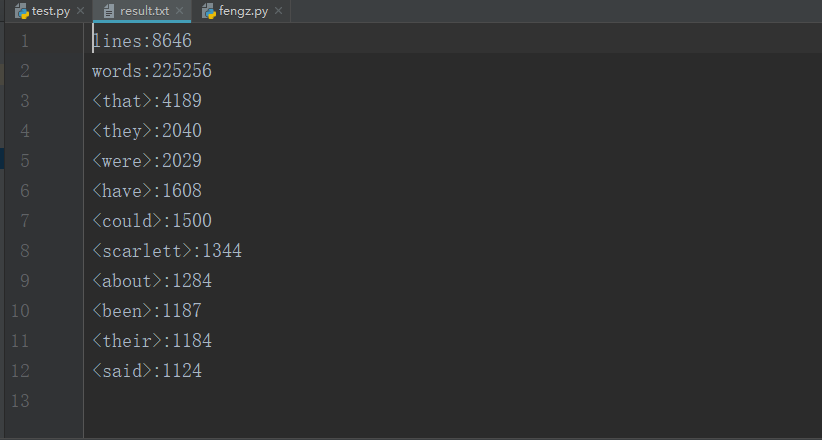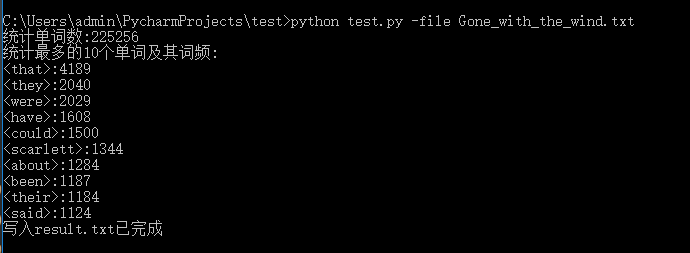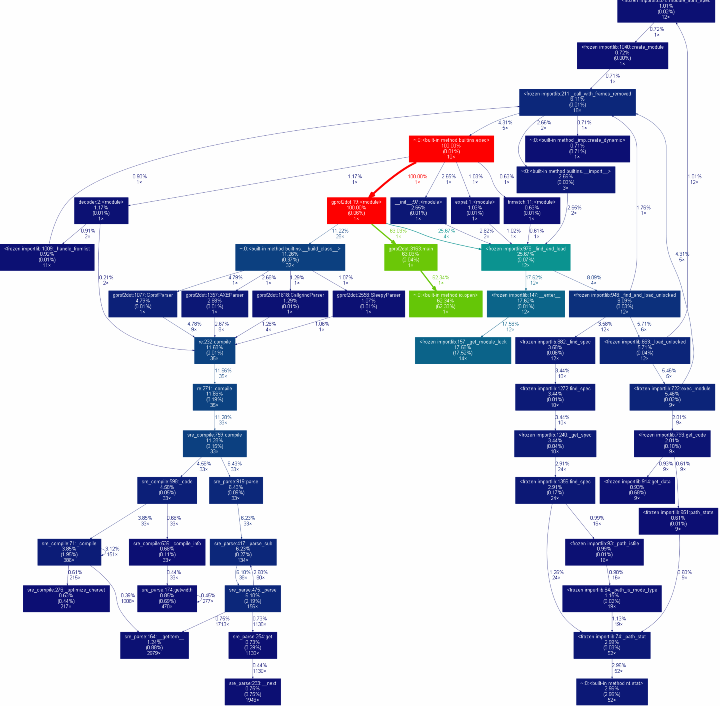软工作业5:词频统计--增强功能
一、基本信息
1、编译环境、作者等信息
编译环境:Pycharm2017、Python3.6
项目名称:词频统计——增强功能
作者: 1613072026:唐顺成
1613072027:吴 涛
2、本次作业的地址:
https://edu.cnblogs.com/campus/ntu/Embedded_Application/homework/2088
二、项目分析
Task 1. 接口封装 —— 将基本功能封装成(类或独立模块)
1.封装好的fengz.py
import re from string import punctuation class wordCount: def process_file(dst): # 读文件到缓冲区 try: # 打开文件 f = open(dst, 'r') # path为文件路径 except IOError as s: print(s) return None try: # 读文件到缓冲区 # 如果文件很大,那么放到列表里计算长度的方法将会很慢,所以循环会更好些 count = 0 for count, line in enumerate(f): count += 1 f.close() f = open(dst, 'r') bvffer = f.read() except: print('Read File Error!') return None f.close() return bvffer, count def process_buffer(bvffer): # 处理缓冲区,返回存放每个单词频率的字典if bvffer: # 下面添加处理缓冲区bvffer代码,统计每个单词的频率,存放在字典word_freq word_freq = {} # 用空格代替标点符号,并且去掉大小写,之后进行正则匹配 bvffer = bvffer.replace(punctuation, '').lower().split(' ') regex_word = "^[a-z]{4}(\w)*" words = [] for word in bvffer: # 判定是否符合单词的定义 if re.match(regex_word, word): words.append(word) txtWords = open("stopwords.txt", 'r').readlines() # 读取停词表文件 stopWords = [] # 存放停词表的list # 读取文本是readlines所以写入list要将换行符取代 for i in range(len(txtWords)): txtWords[i] = txtWords[i].replace('\n', '') stopWords.append(txtWords[i]) for word in words: if word not in stopWords: # 当单词不在停词表中时,使用正则表达式匹配 if word in word_freq.keys(): # 数据字典已经存在该单词,数量+1 word_freq[word] = word_freq[word] + 1 else: # 不存在,把单词存入字典,数量置为1 word_freq[word] = 1 return word_freq, len(words) def output_result( word_freq): if word_freq: sorted_word_freq = sorted(word_freq.items(), key=lambda v: v[1], reverse=True) for item in sorted_word_freq[:10]: # 输出 Top n 的单词 print('<' + str(item[0]) + '>:' + str(item[1])) return sorted_word_freq def save_result(self, lines, words_number, sorted_word_freq): # 保存结果到文件(result.txt) try: result = open("result.txt", "w") # 以写模式打开,并清空文件内容 except Exception as e: result = open("result.txt", "x") # 文件不存在,创建文件并打开 # 写入文件result.txt result.write("lines:" + lines + "\n") result.write("words:" + words_number + "\n") for item in sorted_word_freq[:self.n]: item = '<' + str(item[0]) + '>:' + str(item[1]) + '\n' result.write(item) print('写入result.txt文件已完成!') result.close() def print_result(dst): buffer, lines = wordCount.process_file(dst) word_freq, words_number = wordCount.process_buffer(buffer) lines = str(lines) words_number = str(words_number) sorted_word_freq=wordCount.output_result(word_freq) wordCount.save_result( lines, words_number, sorted_word_freq)
2.测试类test.py
import fengz import argparse if __name__ == '__main__': parser = argparse.ArgumentParser() parser.add_argument('--file', '-file', type=str, default='Gone_with_the_wind.txt', help="读取文件路径") args = parser.parse_args() # 将变量以标签-值的字典形式存入args字典 dst = args.file fengz.wordCount.print_result(dst) #此处为类的调用
3、测试函数的效果:
(1)测试函数在Pycharm中运行截图


(2)测试函数在CMD中运行截图

Task 2. 增加新功能
1.封装好的fengz.py
import re from string import punctuation class wordCount: def __init__(self, dst, m, n, o): # dst:打开文件路径;m:词组长度;n:输出的单词数量;o表示输出文件的存储路径 self.dst = dst self.m = m self.n = n self.o = o def process_file(self): # 读文件到缓冲区 try: # 打开文件 f = open(self.dst, 'r') # path为文件路径 except IOError as s: print(s) return None try: # 读文件到缓冲区 # 如果文件很大,那么放到列表里计算长度的方法将会很慢,所以循环会更好些 count = 0 for count, line in enumerate(f): count += 1 f.close() f = open(self.dst, 'r') bvffer = f.read() except: print('Read File Error!') return None f.close() return bvffer, count def process_buffer(self, bvffer): # 处理缓冲区,返回存放每个单词频率的字典word_freq if bvffer: # 下面添加处理缓冲区bvffer代码,统计每个单词的频率,存放在字典word_freq word_freq = {} # 用空格代替标点符号,并且去掉大小写,之后进行正则匹配 count = bvffer.replace(punctuation, '').lower().split(' ') regex = '' for i in range(self.m): regex += '[a-z]+' if i < self.m - 1: regex += '\s' result = re.findall(regex, bvffer) # 正则查找词组 word_freq = {} for word in result: # 将正则匹配的结果进行统计 word_freq[word] = word_freq.get(word, 0) + 1 return word_freq, len(count) def output_result(self, word_freq): if word_freq: sorted_word_freq = sorted(word_freq.items(), key=lambda v: v[1], reverse=True) for item in sorted_word_freq[:self.n]: # 输出 Top n 的单词 print('<' + str(item[0]) + '>:' + str(item[1])) return sorted_word_freq[:self.n] def save_result(self, lines, words_number, sorted_word_freq): # 保存结果到文件(result.txt) try: result = open(self.o, "w") # 以写模式打开,并清空文件内容 except Exception as e: result = open(self.o, "x") # 文件不存在,创建文件并打开 # 写入文件result.txt result.write("lines:" + lines + "\n") result.write("words:" + words_number + "\n") for item in sorted_word_freq[:self.n]: item = '<' + str(item[0]) + '>:' + str(item[1]) + '\n' result.write(item) print('写入'+self.o+'文件已完成!') result.close() def print_result(self): buffer, lines = wordCount.process_file(self) word_freq, words_number = wordCount.process_buffer(self, buffer) print('统计词组长度为:' + str(self.m) + '且词频前' + str(self.n) + '的单词') lines = str(lines) words_number = str(words_number) sorted_word_freq=wordCount.output_result(self, word_freq) wordCount.save_result(self, lines, words_number, sorted_word_freq)
2、测试类
import fengz import argparse if __name__ == "__main__": parser = argparse.ArgumentParser(description="test example") parser.add_argument('--i', '-i', type=str, default='Gone_with_the_wind.txt', help="读取文件路径") parser.add_argument('--m', '-m', type=int, default=2, help="词组长度") parser.add_argument('--n', '-n', type=int, default=4, help="输出前n的单词/词组") parser.add_argument('--o', '-o', type=str, default='result.txt', help="写入文件路径") args = parser.parse_args() # 将变量以标签-值的字典形式存入args字典 dst = args.i m = args.m n = args.n o = args.o obj = fengz.wordCount(dst, m, n, o) # 将参数传给类 obj.print_result()
3、运行成果截图:
(1)词组长度为1,输出前5词组

(2)词组长度为2,输出前4词组

(3)词组长度为3,输出前5词组,且指定输出路径为re.txt


三、性能分析
(1)使用gprof2dot进行性能分析可视化

四、PSP 表格
1、结对编程时间开销:
|
PSP2.1 |
Personal Software Process Stages |
预估耗时(分钟) |
实际耗时(分钟) |
|
Planning |
计划 |
30 |
25 |
|
· Estimate |
· 估计这个任务需要多少时间 |
120 |
130 |
|
Development |
开发 |
160 |
150 |
|
· Analysis |
· 需求分析(含学习新技术) |
60 |
50 |
|
· Design |
· 编写设计文档 |
30 |
25 |
|
· Design Review |
· 设计复审 |
30 |
35 |
|
· Coding Standard |
· 代码规范 |
10 |
10 |
|
· Design |
· 具体设计 |
50 |
55 |
|
· Coding |
· 具体编码 |
80 |
70 |
|
· code review |
· 代码复审 |
30 |
30 |
|
· test |
· 测试 |
20 |
20 |
|
Reporting |
报告 |
20 |
20 |
|
· Test report |
· 测试报告 |
20 |
25 |
|
· Size measurement |
· 计算工作量 |
5 |
5 |
|
· Postmortem |
·事后总结 |
10 |
10 |
|
|
合计 |
675 |
660 |
五、事后分析与总结
(1)针对某个问题的讨论决策过程:
就cmd运行py脚本传参的问题,我们通过查询,找到了二种方法,1、sys.argv;2、 argparse模块。通过比较我们发现argparse模块对于传多个参数而且argparse模块还包含位置参数,这样让处理命令行参数很快捷和方便。
(2)评价对方:
请评价一下你的合作伙伴,又哪些具体的优点和需要改进的地方。 这个部分两人都要提供自己的看法。
吴涛评价唐顺成 :聪明思维敏捷,乐于帮助我,促进大家学习进步。编程能力强,有发散思维。
唐顺成评价吴涛 :乐于学习新知识,但是Python的知识不够熟练。
(3)评价整个过程:关于结对过程的建议:
(1) 结对编程不仅检验了编程能力,也极高了我们团结合作能力,我们在编程过程中相互鼓励,相互帮助,因为一旦某个功能实现不了,我们会很着急。两个人可以相互鼓励,也同时形成一种良性竞争,比如这个方法是其中一个人想出来的,另一个人就会去思考有没有更快的方法。希望有机会可以再次结对编程。
(2)建议: 有合作就有竞争,相互之间应该,以合作为主,相互学习。
(4)结对编程照片:

(5)其他:
不断的结对合作编程,我们配合的越开越默契,这是一个好的结果,希望我们的合作成果越来越好。



